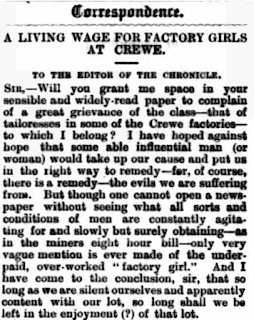It all started with the will of Mary Crewe, spinster, late of Watergate Street in Chester. What struck me was the fact that she had left quite substantial sums of
money to her family and to charity but made her mark with an 'X' in her will. How did she have almost £20,000 in today's money but could not write her name?
| The will of Mary Crewe, 1875 |
Intrigued, I decided to find out more about Mary's story. What followed was a detective trail involving several sources, highlighting the strengths – and weaknesses - of census returns as evidence.
A look on Cheshire BMD shows Mary’s death registered in 1875 and reveals her age as 82, which gives us a birth year of about 1793.
 |
| Entry showing the death of Mary Crewe in 1875 on Cheshire BMD |
This approximate year of birth was my next step for a ‘quick look’ at the census returns for where she lived and who with. Not so quick! A search on Ancestry in the 1871 census for ‘Mary Crewe’(exact) born five years either side of 1793 in Chester gave no results.
However, widening the search for similar names and for places in ‘Cheshire’ instead of Chester provided a promising result.
Mary ‘Creeve’, a 76 year-old cook born in Tilston, is living with her employer, Miss Maria Wynne, a ‘Lady’ and a 19 year-old housemaid, Phebe Williams.
 |
| The census return for 1871 showing Mary Crewe living with Miss Maria Wynne and Phebe Williams in Chester |
A look back at Mary’s will reveals something interesting. Mary names Miss Wynne, spinster, as her executrix (a female executor). So Mary had appointed her employer to carry out her last wishes.
 |
| Extract from Mary's will showing Miss Wynne as her executrix |
The same search using Find My Past correctly identifies Mary’s surname as ‘Crewe’ in the 1871 census. It also gives an entry in 1851 for her as a servant aged 55 in the household of Hugh Calveley and his niece, Miss Wynne, in Northgate Street, Chester. Both Hugh and Maria are described as ‘independent’.
I couldn’t find an entry in Find My Past for 1861 looking for Mary Crewe. However, she’s there in the entry for Miss Wynne and Hugh Calveley, now in Watergate Street. This entry for Mary Crewe aged 63 (born around 1798 at ‘Sellstone’) is picked up clearly by Ancestry, but with an obvious mistake in the index for her place of birth!
With the 1841 census, it’s only when I searched for Mary and Miss Wynne in vain that I found them in the household of Hugh Calveley. The 1841 census rounds ages up to the nearest five years, so Mary’s age here is given as 35 - now we've got a birth year around 1816!
 |
| 1841 census return showing Mary Crewe living with Hugh Calveley and Miss Wynne |
Lessons learnt
·
Even when the name of a person or place seems
clear, be aware that the census returns were transcribed by people with no local knowledge and there are mistakes
· There are clearly differences in transcription
between Ancestry and Find My Past. If you can’t find an
entry on one, try the other!
·
If the person you’re looking for doesn’t appear, try and find other members of the same household
·
Using ages can be tricky. Mary's birth year ranges from 1795 to 1816 according to the census. It could be deliberate or careless reporting, and perhaps the correct age of a
domestic servant wasn't a matter for great accuracy?
Going back to Mary’s will and my original question for a moment …
Mary left £25 to each of her four great nephews and two donations of £19 19 shillings to charity.
As a domestic servant, how was she so well provided for?
The answer lies in the will of Hugh Calveley, who leaves
Mary the sum of £100 in 1868, with the condition that she is still in his
service at the time of his death.
| Extract from the will of Hugh Calveley, 1868 |
Miss Wynne’s will, made in 1868, leaves an annual allowance to Mary of £26 and a codicil, amending her will after Mary’s death, leaves £19 19 shillings to Phebe Williams, the housemaid). Curious that same amount appears in both wills, just under the £20 limit that you had to pay legacy dues to the taxman!
What does this indicate about long term employees and their
employers?
Clearly both Hugh and Miss Wynne valued their staff, Mary Crewe in particular. There’s an entry in the Cheshire Observer on 11th December 1875 for Mary’s death, which describes her as ‘…for 60 years the faithful and attached servant of Miss Wynne’s family’.
 |
| Cheshire Observer, 11 December 1875 |
Another thing that struck me looking at this story – it is far from the full story! We see Mary’s life and circumstances as a glimpse every ten years and have to piece together what we can from the fragments the census returns give us (and not always willingly!).
Looking for Mary, we find Maria and her bachelor uncle, Hugh. How did they become a household for so long? What else can we discover about them?
Our Overleigh Cemetery database shows an entry for Mary and the UK Find a Grave database on Ancestry takes us to an image of Mary’s grave there. She’s buried with her brother, George and somebody called Hannah... but that is another story!
Think about the information we have provided on the census
returns throughout our lives, what would a researcher far in the future make of our stories?




